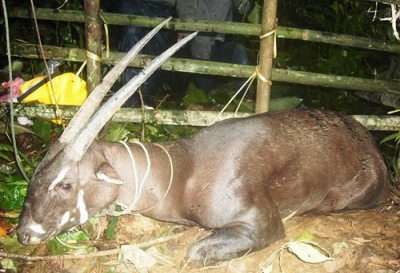They get you, don’t they? Those big, unanswered questions of existence. What is dark matter? How did the universe get started? Why is Miley Cyrus? Who put the Benzedrine in Mrs Murphy’s Ovaltine?
Science presented as a list of pre-digested facts that we must obediently learn is rightly condemned as dull – but that’s not what science is about. No, science is a long list of unanswered questions, a voyage into the unknown, a quest to reach for things slightly beyond our grasp. Be honest, now: who’d really rather go on an adventure with Indiana Jones than be lectured at by Richard Dawkins?
Even today, when science is so often a world of pristine laboratories and humming machinery, the old-fashioned, down-and-dirty spirit of adventure pokes through. Just when you’d imagine that everyone has an iPod, and that we’d shaken every tree and looked behind every bush on the planet, some creature walks into view that is entirely new to science.
Not tiny creatures, either, such as sea urchins living obscurely on the ocean floor, miles below the surface; or near-microscopic wasps that lay their eggs in the pupae of jungle-living butterflies; or bacteria only found in sulphurous slag heaps. Sure, such things are being found all the time, and each and every one is a wonder. Oh noes, I’m talking about big creatures that everyone would recognise as such, living on land accessible to people with no special equipment except their own eyes.
As recently as 1993, a scientific paper landed on my desk at Nature describing a species of antelope hitherto unknown to science. And not some cute little creature that could slip between your knees and hide coyly behind a leaf, but a beast big enough to bump into, and do you serious injury if it stepped on your foot. How could people in this overcrowded world have missed it?
The location was a start. The saola, for such is its name (its more formal handle is Pseudoryx nghetinhensis), comes from the remote and deeply inaccessible Annamite Mountains on the border between Laos and Vietnam, a kind of Lost World known for hosting other rare species. Even if you can hack your way in, the saola is pathologically shy, and goes out of its way to go out of its way.

The scientific description was not based on a live animal, or even a dead one, but hunting trophies – horns, skulls and skins of several animals collected from the houses of local hunters. The live animal had not been seen. To my perhaps jaded editorial eye, the report seemed to have come straight out of King Solomon’s Mines. How romantic!
The saola is, in fact, so shy and secretive that it wasn’t until 1998 that it was photographed alive in the wild – and then only fleetingly. In 1999 it disappeared from view altogether. It was only in September 2010 that a live saola was captured. It obligingly stayed alive long enough to pose for its portrait whereupon it expired, presumably unaccustomed it its unwanted celebrity. The number of saola in existence is unknown, but it is likely to be small, and getting smaller all the time.
The saola joins a select band of large mammals discovered relatively recently, all of which are (not surprisingly) rare to the point of vanishment. A wild pig, the Chacoan peccary, Catagonus wagneri, was known only from fossils until it turned up on the wild borders of Bolivia, Paraguay and Argentina in 1975, and is believed to be hanging on by its trotters.
A wild ox called the kouprey, Bos sauveli, a cousin to the saola, was described in Cambodia in 1937. There were around 1,000 of them in 1940; down to around 100 in 1969; and it hasn’t been seen at all since 1983. This strongly suggests extinction, as creatures as big and beefy as the kouprey would be hard to miss.
Other creatures hardly touch the zoology texts before disappearing entirely: the red gazelle, Eudorcas rufina, is only known from skins discovered in Algerian souks in the nineteenth century. It has never been seen alive.
That such large creatures roamed the Earth until present times before dying out is a reminder of humanity’s remorseless conquest – hackneyed, to be sure, only because of its frequency of repetition. But there’s a wider point to be made here, about how little we know even about large mammals (let along squashy creatures from the abyss, or microbes), and the degree to which the documentation of recently extinct creatures grades from certain knowledge into myth. The Chacoan peccary was known from fossils until live ones were found. The saola was described from trophies before live examples were seen. The red gazelle is only known from such trophies. And where antelopes, oxen and pigs lead, humans will follow.
If stone tools are any guide, human beings – of one sort or another – have been living on the relatively far-flung island of Flores in Indonesia for a million years at least. By “one sort or another” I mean exactly that – as far as we know, modern humans didn’t arrive on Flores until a little before 10,000 years ago. The previous residents were (presumably) related to the extinct form Homo erectus.
The announcement in 2004 of an entirely unknown species of extinct human that lived on Flores – Homo floresiensis, or “The Hobbit” – caused a sensation. The small size and unique morphology of this creature is still a field of battle between those who contend that it is a real species, against those who think it is a diseased form of modern human. But what is really remarkable is the age. Initial findings showed that H. floresiensis lived on Flores from before 38,000 years ago to as recently as 18,000 years ago. Further work extended the range from as long ago as 95,000 years to as recently as 12,000 years ago.
Given the great age of the Earth, 12,000 years is very much less than an eyeblink. That an animal became extinct 12,000 years ago, or yesterday, hardly matters, for in the great scheme of things, this difference is insignificant. If the Chacoan peccary came to life from fossils, and if the saola emerged alive – if only just – from the Annamites, it is entirely legitimate to ask whether H. floresiensis, or something like it, still exists, or, perhaps, became extinct in historical times: a human version of the red gazelle, perhaps.
And if one admits H. floresiensis to the canon, what of other celebrated mythical beasts – if not necessarily Nessie, then the orang pendek of Malaysia? The yeti? The sasquatch? Bigfoot? Are all such creatures the products of delusion, conspiracy theories and hoax? Perhaps – but not necessarily. The little we know of those large mammals on the fringes of knowledge suggests that they live in remote places, are very shy, are extremely rare, and that to find them before they become extinct requires a degree of luck. So far, no hard evidence for yetis (say) has emerged. But in a world that hosts H. floresiensis and the saola, the kouprey and the red gazelle, one should keep an open mind.
Henry Gee is a senior editor of Nature. He blogs at The End Of The Pier Show. He will be speaking at the Grant Museum, University College London, on 26 October. [630pm; UCL Darwin Lecture Theatre; free admission].
